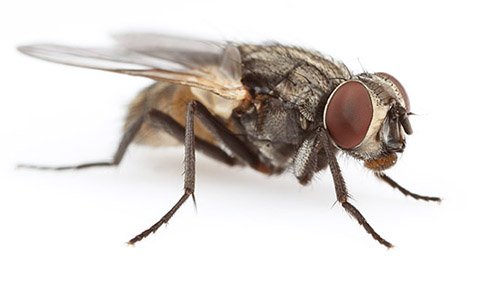A Origem das moscas | The Origin of the Fly
[PT] Olá pessoal, tudo bem? Hoje vamos falar sobre a origem da mosca. As moscas são insetos muito comuns em todo o mundo e podem causar problemas de saúde. Mas você sabe como elas surgiram?
[ENG] Hi everyone, how are you? Today we're going to talk about the origin of the fly. Flies are very common insects all over the world and can cause health problems. But do you know how they came about?

(fonte: imagens google)
[PT] Acredita-se que as moscas tenham surgido há cerca de 65 milhões de anos, no período da extinção dos dinossauros. Nessa época, os mamíferos pastadores começaram a se diversificar e as moscas aproveitaram essa oportunidade para se adaptar a esse novo nicho ecológico.
Os primeiros ancestrais das moscas eram insetos pequenos e sem asas. Eles se alimentavam de detritos vegetais e animais. Com o tempo, essas espécies foram evoluindo e desenvolvendo asas. Isso permitiu que elas se espalhassem para novos habitats e se adaptassem a diferentes condições ambientais.
A diversificação das moscas foi impulsionada pela evolução dos mamíferos pastadores. Esses animais produzem grande quantidade de matéria orgânica em decomposição, o que forneceu um alimento abundante para as moscas.
As moscas se adaptaram a diferentes tipos de ambientes. Algumas espécies vivem em áreas urbanas, onde se alimentam de lixo e restos de comida. Outras espécies vivem em áreas rurais, onde se alimentam de fezes de animais e de cadáveres.
[ENG] It is believed that flies emerged about 65 million years ago, during the period of the extinction of the dinosaurs. At that time, grazing mammals began to diversify and the flies took advantage of this opportunity to adapt to this new ecological niche.
The first ancestors of flies were small, wingless insects. They ate vegetable and animal debris. Over time, these species evolved and developed wings. This allowed them to spread to new habitats and adapt to different environmental conditions.
The diversification of flies was driven by the evolution of grazing mammals. These animals produce a large amount of decomposing organic matter, which provided an abundant food source for flies.
Flies have adapted to different types of environments. Some species live in urban areas, where they feed on garbage and food scraps. Other species live in rural areas, where they feed on animal feces and carcasses.


(fonte: imagens google)
[PT] A mosca doméstica (Musca domestica) é a espécie de mosca mais comum no mundo. Ela é encontrada em todos os continentes, exceto na Antártida.
A mosca doméstica tem corpo alongado, com cerca de 1 cm de comprimento. Ela tem asas transparentes e uma coloração cinza-escura.
A mosca doméstica é um inseto necrófago e se alimenta de matéria orgânica em decomposição. Ela também se alimenta de alimentos humanos, como frutas, legumes e carnes.
A mosca doméstica é um vetor de doenças, como a disenteria, a cólera e a tripanossomíase. Ela transmite essas doenças ao contaminar alimentos e água com suas fezes.
[ENG] The house fly (Musca domestica) is the most common fly species in the world. It is found on all continents except Antarctica.
The house fly has an elongated body, about 1 cm long. It has transparent wings and a dark gray color.
The house fly is a necotrophic insect and feeds on decomposing organic matter. It also feeds on human food, such as fruits, vegetables, and meats.
The house fly is a vector of diseases, such as dysentery, cholera, and trypanosomiasis. It transmits these diseases by contaminating food and water with its feces.

(fonte: imagens google)
[PT] As moscas são insetos importantes para o meio ambiente, pois ajudam na decomposição da matéria orgânica. No entanto, elas também são uma praga para os humanos, pois podem transmitir doenças.
Adoptando medidas de higiene e limpeza, é possível reduzir a população de moscas e evitar a transmissão de doenças.
[ENG] Flies are important insects for the environment as they help in the decomposition of organic matter. However, they are also a pest to humans as they can transmit diseases.
By adopting hygiene and sanitation measures, it is possible to reduce the fly population and prevent the transmission of diseases.
(Fonte do texto: Brasil Escola)
#hive-xxx #hivebr #hiveblog #blogging #vlog #dbuzz #gems #education #stemsocial #stem #eons #pob #pimp #hive-engine #neoxian #stemgeeks
Your post was manually curated by @CrazyPhantomBR.
Delegate your HP to the hive-br.voter account and earn Hive daily!
🔹 Follow our Curation Trail and don't miss voting! 🔹
Obrigado por promover a comunidade Hive-BR em suas postagens.
Vamos seguir fortalecendo a Hive
Congratulations @g4tzbr! You have completed the following achievement on the Hive blockchain And have been rewarded with New badge(s)
Your next target is to reach 100 posts.
Your next target is to reach 5000 upvotes.
You can view your badges on your board and compare yourself to others in the Ranking
If you no longer want to receive notifications, reply to this comment with the word
STOPTo support your work, I also upvoted your post!